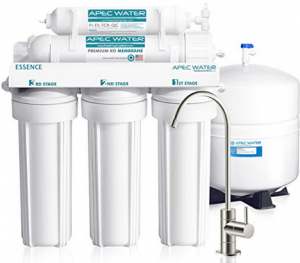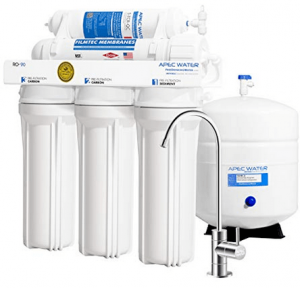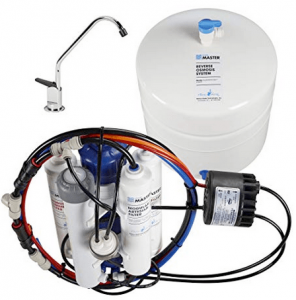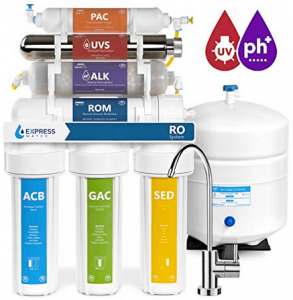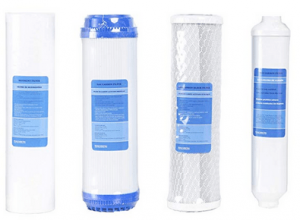2025 Best Reverse Osmosis Water Filter and Guide
A Reverse Osmosis Water Filter is paramount to have if your water source needs a thorough treatment.
A reverse osmosis water filter is often one of the best filtration systems to have at home (or office) if you believe the water source contains numerous contaminants.
That is why it is important that you:
- Have access to the local consumers report.
- Understand what potential contaminants are present in the municipal water.
- Determine how much water you want to treat and,
- Buy the best water test kit to assess the pollutants present in your tap.
Best reverse osmosis system in 2025
Luckily, there are a few good choices in the market in 2025. With the information above in mind, this is what I think are the best reverse osmosis water filters.
How do I know this?
Because what other users have said in regards to their benefits, limitation and overall value for money.
APEC ROES 50 (Essence Top Tier 5) Review
This APEC ROES 50 reverse osmosis system is one of the budget choices we included on our list, due to its convenience.
Essence top tier 5 general specs
As its name suggests, the APEC ROES 50 is a five (5) stage filtration system designed to remove up to 99% of most common contaminants including heavy metals, chlorine, fluoride, particulate solids, bacteria, and viruses.
Medium to high efficient, the system has a wastewater pure water ratio of 3:1. In addition, it uses a double carbon blocks system designed to achieve maximum chemicals and chlorine removal.
This configuration also increases the lifetime of filters and membrane.
On average, you’ll have to change the filters every six (6) to twelve (12) months. The RO membrane every two (2) to three (3) years.
Other features
The APEC RO system filters both tap and well water, removing even particles with a size of 0.001 microns.
Like most under sink filters, the APEC water filter is fairly easy to install and comes with comprehensive written instructions and videos need for mounting.
We also liked the true leak-free fittings equipped with stainless steel teeth for guaranteed grip on the tubing.
Once the system is installed, you’ll be able to enjoy the benefits of this unit capable of outputting up to 50 gallons per day and working at a pressure between 40 and 80 PSI.
APEC RO 90 Review
If you liked the system above but feel you could use more than 50 gallons of water a day, then the APEC RO 90 could be the right reverse osmosis water filtration system for you.
RO 90 expectations
This system preserves most of the features of the Essence Top Tier 5 stage, however it incorporates high-grade polypropylene sediment filter, double extruded carbon block, and TFC reverse osmosis membrane.
Easy to install under the sink and requiring minimal maintenance, this APEC reverse osmosis system comes with a four (4) gallon tank and can output up to 90 gallons per day at a feed water pressure of 85 PSI.
Regarding efficiency, it is WQA gold medal certified to remove up to 99% of contaminants including chlorine and fluoride, heavy metals, arsenic, viruses, and bacteria, alongside multiple other contaminants.
Lastly, the APEC RO 90 has certified fittings to ensure there is no leakages after the setup (as long as you follow the instructions and check its integrity before its operation.
What could be a deal breaker?
APEC has really good filtration system but the limitation could be a problem.
I think either the RO 50 and RO 90 are good alternatives but the lack of UV filtration could be a deal breaker.
Of course, this is only in case you find out the water supply has high level of viruses or bacteria.
AquaTru Reverse Osmosis Review
AquaTru appeals to those who are after a portable reverse osmosis water filter. This classic system is said to remove more than 80 potential contaminants from tap, filtered and bottled water, and the dispensable tank is small enough to be removed and stored in the fridge for a cold, refreshing, filtered water experience.
Ready to use straight out of the box, the AquaTru reverse osmosis could be used as a countertop water purification system or as a portable device.
I think what makes it good is the fact that you can have one (1) gallon of tap water in 15 minutes (54 gallons a day) so cooking outdoors should be easy.
Stages and specification
To treat the water, it uses a four (4) stage filtration process to provide clean water without the hassle of under sink installation.
This compact countertop reverse osmosis filter takes less than three minutes to set up.
In addition, all its elements have been NFS certified.
It removes over 70 contaminants present in water including a wide range of heavy metals, chlorine, and fluoride.
To do the treatment process, it includes includes an activated carbon pre-filter (stage 1) as well as a coconut shell carbon (stage 2).
This two will ensure that TDS and semi-volatile (SVOC) compounds are removed.
The stage 3 is basically the RO phase. Lastly, the stage 4 will remove any sneaky particle such as volatility organic compounds.
Maintenance is easy, thanks to the twist and seal filter design, and each filter lasts between six (6) months and two (2) years, depending on type of water and usage.
Of course, you can check if the lights are indicating time to change a filter.
The downside of this portable reverse osmosis water filter
AquaTru water systems imitates the reverse osmosis process used by most under sink systems. Nevertheless, it is not as perfect as more sturdy RO systems.
The biggest issue I see with this RO filtration system is the need to connect it to a power supply. It is great as a portable device as along as you can power it.
Aside from the above, having electronics involved is not my favorite. When it breaks, you may need to replace the whole unit.
All in all, the AquaTru reverse osmosis water filter is not a bad system and will surely do what you need if you have the means.
Whirlpool WHAROS5 Reverse Osmosis
The Whirlpool WHAROS5 is a three (3) stage RO system, with a nice and clean design.
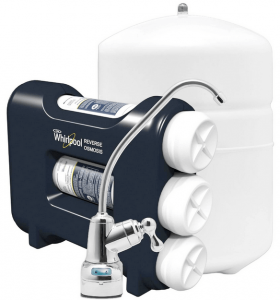 |
|
Benefits
|
Limitations
|
Of course, I think the way it looks is not the important part, as this will be stored under your counter. It’s more important to consider if the water will be properly treated and how much space you need for installation.
I can say that the filtering process is effective to remove most common contaminants such as heavy metals, organic and in-organic compounds and most pharmaceutic chemicals.
Similar to the AquaTru model, this one lacks of a UV filter.
In case the water source has a high concentration of micro-organisms, this may be not the right system to buy.
Aside from other downsides (find more by reading our full review), I know that the Whirlpool WHAROS5 can offer good benefits as a reverse osmosis system.
Home Master TMHP Hydroperfection
If you have enough budget for a medium scale reverse osmosis system, the Home Master TMHP Hydroperfection undersink reverse osmosis water filter system could be the one for you.
Basically, it has a six (6) stage water treatment process.
At first glance, it may look a bit messy as in the tubing distribution. The good thing is that the whole system is per-assembled.
Also, I actually think it looks very professional and convincing.
The Home Master TMHP Hydroperfection has what is needed to filter water from the obvious municipal supply but also from private wells.
Of course, the limitation are always there. I would say the biggest limitation is the required space to install under the kitchen’s sink.
Regardless of that, I think this RO system is a better option compared to the above reviewed systems (if you need a more detailed filtration process).
Express Water Reverse Osmosis
Express Water is a brand that manufactures a broad range of different water filtration systems, many of which are acclaimed for their effectiveness, making it one of the most renowned suppliers in the market.
This review is applicable for any of the filters offered, where the main difference is the number of stages.
From six (6) stage to eleven (11) stage alternatives, you will have a few options to look at.
From all the options offered by this brand, my favorite would be the Alkaline plus UV light water filter.
This Express Water RO system would be an eleven (11) stage process.
Why do I think this is a good buying option?
Frankly, it has all the filters required to treat any water source but the addition of an alkaline stage, makes it better.
It is known that most RO systems could remove important minerals for the proper hydration of your body.
This is where the alkaline phase is important. Aside from the treatment side, its structure is compact and easy to allocate under the sink.
Express Water limitations?
Having a few filtration stages could be beneficial but too many is, in fact, a problem.
One of the main things is the cost. This is the case for the eleven stage RO filtration system. Do you need something so sophisticated?
Compared to other similar models, this one is expensive.
Another one is the filter replacement time. When to replace it? which one to replace? I think these questions are not so easy to answer.
Overall, if you know what the quality of your tap water is, Express Water will provide the most suitable alternative.
REVERSE OSMOSIS WATER FILTER OVERVIEW AND BUYER’S GUIDE 2025
Installing a reverse osmosis water filter in your home is perhaps the easiest and most economical way to have access to pure drinking water.
Before buying any reverse osmosis filtration system, there are a few objective criteria you should consider though. To begin with, you should understand how this system works.
What is reverse osmosis water filter process?
Reverse osmosis (RO) is the process of water demineralization and/or deionization by pushing the liquid (water) under pressure so it goes through a semipermeable membrane.
This is only possible by applying an external pressure, which reverses the natural flow.
The RO membrane usually has 0.001 um pore size so even mineral are removed.
How does reverse osmosis work?
These systems use a high-pressure pump to force the water go through the RO membrane, leaving up to 99% of chemical contaminants in the wastewater stream.
The wastewater that is generated during the filtration process is separated and discharged directly to the drainage system.
Because reverse osmosis is only responsible for the demineralization of water, most RO units also come equipped with post alkaline filters developed to improve the taste of purified water.
About the reverse osmosis filter
Aside from the actual membrane filter, most domestic RO filtration systems will include a variety of filters, such as:
- sediment trap for the removal of large particulate solids and,
- active carbon filters mainly for the elimination of organic and inorganic compounds.
In addition, more complex setups will have a UV light water filter.
The filtration elements used for each one of them will depend on the manufacturer sophistication.
Which system is best to use? There is no right or wrong answer. At the end, the main difference between brands is their lifespan and size.
RO Storage Tank
To finally understand how does reverse osmosis work, we need to talk about the storage tank.
As you have already learnt, the reverse osmosis process generates a sub-product classified as “waste”.
The storage tank is then, what the system needs to accumulate the post membrane treated water.

- delivered directly into your faucet or appliance or,
- transferred towards other filters for additional treatment or water taste improvement.
Why to have a storage tank is so important?
Well, the size of the RO membrane pores are so small that the output pressure is very low, therefore it will take ages to fill up a glass of water.
So, to keep up with the water demands of a family (or even a single person), the tank will provide a higher output pressure and flow.
Now, what about the tank pressure?
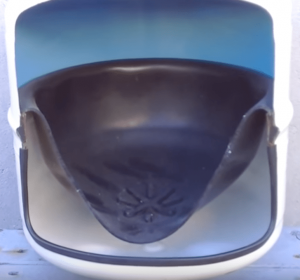
This is an important factor to check for a proper operation of any reverse osmosis filter system.
If the pressure inside the tank is to high, the water coming through the system will no be able to push the bladder down completely.
This means less water stored, the filters will be working more frequently, reducing the filters lifetime.
On the other hand, pressure below the recommended will result in low water flow towards the faucet, defeating the tank purpose.
|
NOTE (tank troubleshooting)
|
Lastly, usually the size of a RO system tank varies from 2 to 4 gallons. It will depends on the amount of water that you required to be filtered and the system brand.
Some other systems such as the APEC RO 90 will offer a larger storage if required.
How much water does reverse osmosis filter waste?
Every RO system is different. Some high-end configurations (e.g, Home Master TMHP) will have an efficiency of 1:1 (1lt wastewater per litter treated).
The worst case waste efficiency ration I’ve seen is 4:1. This, of course, is not good for the environment.
Benefits and Common Problems of RO Systems
Like pretty much anything else, any reverse osmosis water filter comes with benefits and limitations.
Lets discuss some of the advantages of having a domestic RO filter system.
Reverse osmosis water benefits
- It removes more contaminants than other water filter systems.
- Other filters, like alkaline made, can be added to improve the taste the of treated water.
- Most reverse osmosis water filters are fully automated.
- Depending on the filter arrangement, it could be easy to maintain.
- they could be a great alternative for filtering water to a whole house.
- The latest ones in the market, can be energy efficient and cost-effective in the long term.
- No matter the water source (as long as you have the right configuration).
- Some manufacturer also offer portable solutions or can be benchtop.
- Large volume of water delivered.
Disadvantage of RO water
On the flip side, these are some of the common problems that users face with RO filtration systems.
- Reverse osmosis filters are prone to clogging. This is more common when the water is sourced from private wells or surface bodies high level of sediments.
- The filtration process could be rather slow because of the large number of filters.
- Having too many filters means a lot of items to worry about in case of a single damage.
- The water tank could eventually loose pressure due to an internal damage of the bladder.
- If the tank is faulty, it cannot be repaired.
- The vast majority of RO systems require a power supply to operate.
- Last but not least, they are more expensive than other water filtration systems.
Overall, I see there is a fine balance between the advantages and disadvantages of reverse osmosis.
Is reverse osmosis the best water filter system? Again, this will depend on you needs, nevertheless it is better than other standard water filters.
Think twice before buying one of these systems.
Reverse Osmosis Water Filter Options
One of the most important things to consider before buying a reverse osmosis water filter is its type. We can distinguish between three (3) solutions:
Portable reverse osmosis water filter
It is ideal for the outdoorsy people who want to treat water during their adventures.
Portable filers are perfect for RVs and some models are compact enough to take in your travels such as the AquaTru RO models.
A portable reverse osmosis water filter is great to take in countries where tap water is unsafe to drink if you want to save on bottled water.
Unfortunately, most of them will require a power supply to function.
The good new is that you can always source a different portable water filter such as Katadyn Hiker Pro.
Countertop reverse osmosis water filter
It is perfect for those who have little under sink space. This type of RO filter is typically compact and ideal for small homes.
One problem I see with this alternative is how it could mess with your kitchen’s look.
If you don’t care about this, go for it.
Under sink reverse osmosis system
It is by far the most popular. This system goes under your sink and connects to the water supply pipe.
Once installed, the system requires no other intervention from your side except for periodical filter replacement.
It’s great for those who want a permanent water filtration system.
About the Reverse Osmosis Filtration Stages
RO water filters come in an assortment of choices, from smaller portable or countertop configuration to top-end designs that employ up to eleven (11) stages.
Each stage refers to what the filter removes or adds to the water.
We will only discuss the most common water filtration stages:
Stage 1
The first three (3) stages consist of filters present in most domestic water filtration systems. During the first (1) stage, water passes through a sediment filter that retains larger particulate solids.
Stage 2 & 3
Following stage 1, the second (2) stage is to pass the water through two (2) carbon filters (usually a combination of granular activated carbon (GAC) and a carbon block (CTO).
It can be also be a combination of GACs or CTOs, designed to remove harmful chemicals, pharmaceuticals, organic compounds (such as hydrocarbons) and heavy metals.
Stage 4
The fourth (4) stage is usually the reverse osmosis filtration (membrane) that removes harmful ions and minerals. This is considered the heart of the whole filtration process.
Stage 5
Five-stage (5) filters systems also contain the last carbon filter (CTO) developed to improve the taste and odor of the water
Also can remove volatile organic compounds that could’ve gone through the previous stages (this could happen if the filters are getting saturated).
Stage 6 and above
High-end filters with six (6) stages or over also employ water mineralization and UV filters developed to enrich the water with healthy minerals and kill harmful bacteria.
What to Consider When Buying a Reverse Osmosis Water Filter
Pollutants to filter
The first thing you must determine is what contaminants the reverse osmosis water filter needs to remove.
Most systems can effectively remove chemicals and heavy metals from water, but if you’re concerned of waterborne diseases, know that only those systems with UV filtration can do the work.
The volume of water you require
Most RO systems can filter between 50 and 100 gallons per day. The less they filter, the cheaper they are, so consider your real needs before buying.
Keep in mind that the system storage tank capacity influences on how much water is available after treatment.
Tap pressure and flow rate
Reverse osmosis water filters usually require a high feed water pressure for correct operation.
Most units require at least 40 psi.
If you have well water and struggle to get constant pressure, opt for a system with a minimum pressure requirement of 30 psi.
In addition, some systems would have an external pump to improve the water pressure.
The flow rate is also important.
If you want to enjoy a flow rate similar to tap water, aim for a system that can output around at least 0.8 gallons per day.
Finals location of the reverse osmosis water filter
Under sink water filters can be bulky and take up much of the space.The good news is that most recent systems are more compact and are design towards smaller kitchen areas.
If you need a smaller system, a portable or countertop RO filter could be a better choice, however keep in mind they have a lot of limitations.
Maintenance and filters replacement
Reverse osmosis filters require little to no maintenance once they are installed.
You’ll have to replace the cartridge periodically to keep the quality of the filtration system.
Most entry-level and mid-range filters will require to be changed within the year, whereas high-end more than a year.
This is obviously affected by:
- the sediment concentration of the water and,
- the usage of the system.
Efficiency vs Cost
The last but not least is how efficient the system could be and its associates cost.
A sophisticated reverse osmosis water filter system will deliver efficiency when treating water. The downside will be always the associated cost.
In terms of the environment, you should also think about how much waste is produce during the filtering process. Below some facts:
| Mid-range units, typically waste three (3) gallons of water for each gallon of pure water on average.
High-end units increase efficiency and have a wastewater pure water ratio of one (1) to one (1) . |
All in all, although these systems are more expensive, they are cheaper in the long run and bring great value for money.
Best reverse osmosis system verdict
From the six (6) main reverse osmosis water filter alternatives listed here, I think the best reverse osmosis system for home use would be the Home Mater Hydroperfection.
In general, this RO system has the minimum required elements to removed most common contaminants present in potable water.
Adding to that, I love that the wastewater ratio is 1:1, which at the end also benefits our environment.
Lastly, the cost. I know most of us put our wallet first that any other factors.
Compared to similar competitors, there is a few dollars that can be saved.
2025 Best Reverse Osmosis Water Filter Table Summary
[ctu_ultimate_oxi id=”1″]
Reverse Osmosis Water Filter Reviews and Guide Wrap Up
If you want to make sure you’re consuming clean water you have to filter it yourself.
There are many systems in the market, such as the ones reviewed at the start of this long article (and summarized below).
Whether you need a portable filter for your RV, a compact countertop solution or a full-size under sink water filtration system, it all lands in the fact of what you want to filter.
All units mentioned in this review bring true value for money, so you can pick the reverse osmosis water filter that best suits your needs.

